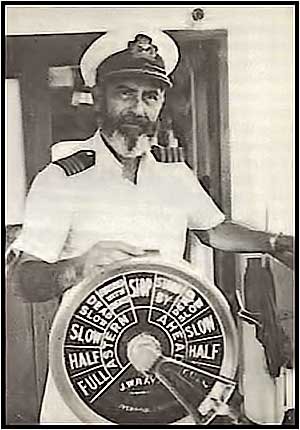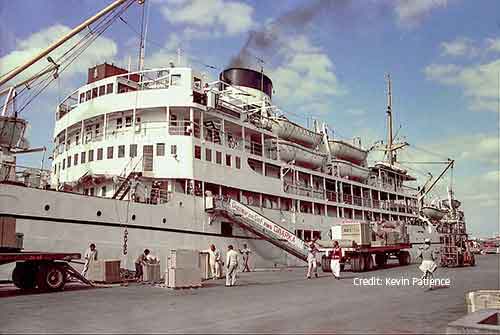
This a story of a 1978 voyage on mv Dwarka from India to Dubai
A British India Steamship Company's ship,
just before this service came to an end.
Captain Hankin

Captain G. A. Hankin was born in Ootacamund, the famous hill-station in the Nilgiri Hills near Madras.
His father was a British India Master whose ship was based on Madras.
Traditionally these British India Steam Navigation Company Captains (or Masters) made their home in India.
Though Capt. Hankin's home is now in Hampshire, he still spends most of his time in India, based on Bombay.
His ship is the mv Dwarka, the last of the British India passenger ships still operating from the subcontinent.
mv Dwarka

Dwarka (launched 25th October 1946 and delivered 25th June 1947) is the survivor of a magnificent tradition, and when she goes, as she is likely to within the next few years, an era will end in British shipping history.
Dumra carried 20 1st class, 30 2nd and 1,537 deck passengers. 1977 deck passengers part replaced by 445 bunked. 1979 52 cabin, 534 bunked and 533 deck passengers. 130 crew. her speed was 15 Knots.
mv Dwarka alongside at Port Rashid Dubai
The British India Shipping Line

The British India Line was inseparably linked with British imperial history in India, in South-East Asia, and in East Africa. Its history was the history of Scots enterprise in the East. Through its founder, Sir William Mackinnon, its expansion matched the expansion of British influence in the Indian Ocean and the Gulf, particularly through Mackinnon's company the Imperial British East Africa Company, and the B.I. agencies Mackinnon, Mackenzie and Gray Mackenzie.
Capt. Hankin joined the B.I. company in 1946, just before the British granted independence to India, and just at the time that the Dwarka and her three sisters, Dumra, Dara and Daressa were being planned and built for the Gulf service. Since then he has served on, among other services, the three main passenger routes of Mackinnon's Indian system, Madras to Singapore, Bombay to Durban, and Bombay to the Gulf.
The first two of these services survived respectively to 1973 (when Capt. Hankin was one of the last masters of the Rajula on the Straits service), and 1976, when the Karanja was withdrawn from the East Africa service. Only the Gulf service survives, and survives in a remarkably healthy state, at least partly due to Capt. Hankin's experience and expertise in this particular kind of trade.
Dwarka is a place regarded as one of the four corners of India, in the west in the Jamnagar region, near the mouth of the Gulf of Kutch. The holiest of Hindus regard it as a source of veneration to visit these four corners. But the motorship Dwarka sails West beyond this far corner of India, and she survives because the particular conditions of the Gulf have preserved the patterns of labour migration that were so important in the British Indian ocean empire.
The Gulf
The Gulf is not only one of the richest areas of the world, it is also under-populated. The growth of its principal towns and city states has been entirely dependent upon labour migrants from India and Pakistan. The Dwarka is capable of carrying nearly 1,000 such migrants in her deck spaces, and is often full, at least for the Muscat to Karachi leg of her voyage.
So it is as the principal carrier of modern labour migrants, the survival of an essentially 19th century trade, that the Dwarka has become the last passenger vessel of British registry employed on a scheduled route around the year. She is now almost alone in the trade, maintaining a service she has operated consistently for over 30 years, connecting Bombay and Karachi with Muscat in Oman, Dubai in the United Arab Emirates, Doha in Qatar, Manama in Bahrein, and Kuwait. In the past she also served Bandarabas, Basrah, and Bushire, as well as some other ports from time to time.
Capt. Hankin has enjoyed his years in the Gulf (he first became Master of the Dwarka in 1971), both because of the intrinsic interest of the trade and the route, and because of the opposition that has from time to time been ranged against him. Kuwaiti, Pakistani, and Indian ships have all operated in competition. Two of the Indian vessels are, ironically enough, ex-B.I. ships, the Karanja which became the Nancowry and the Dumra. sister ship of the Dwarka which was re-named Daman. Neither of these was to be seen when the author travelled in the Dwarka in March and April of 1978. An Indian lady passenger travelling to the Gulf on holiday complimented the Dwarka for her cleanliness, food and punctuality. Capt. Hankin is proud of this reputation, and works hard to keep it.
"I myself check that the deck passengers' food is up to scratch; despite the numbers, the crew treats the passengers with respect and politeness; we provide entertainment by showing films almost nightly", Capt. Hankin told me.
The Crew
His crew (there was a complement of 132 when I travelled) is mainly Indian and Goanese, although the majority of officers are British. Capt. Hankin is far from being the only one who has inherited a family tradition. One of the senior pursers also had a father in the line. One of the crew, a lad from Goa, told me that both his father and his grandfather had worked for the line, and claimed that his grandfather had actually died on the ship. Many have themselves been with British India for decades, and they represent splendidly old-fashioned traditions of service. As a historian of India, I was delighted to become "the passenger sahib" the moment I boarded.
The Voyage
The Dwarka was the second of the four "D's" built for the trade after the war. She was completed by Swan Hunter and Wigham Richardson Ltd., Wallsend in 1947 (she had been preceded by the Dumra in 1 946, and was succeeded by the Dara in 1948, and the Daressa in 1950, all from the same yard, Barclay, Curie on the Clyde. She is propelled by Doxford oil engines — though there is much steam equipment about — and normally uses a service speed of about 13 knots. Her engines have become a source of fascination to engineers on other vessels of the P&O Strath services (of which the Dwarka is now a part), for her Scotch boilers and many other characteristics are now seen virtually as museum pieces.
The Captain's accommodation and wireless room lie immediately abaft the bridge. The boat deck below carries most of the officers' accommodation, the deck officers forward, the engineering officers aft. The promenade deck has a lounge and library forward, three single, six two-berth and two three-berth cabins, and a bar and smokeroom midships. Aft is a deck house with berth space for "special trade" passengers, together with a small portion of the deck for their "airing".
"A" deck has saloons fore and aft, for officers and cabin passengers in the former case, for warrant officers in the latter. The rest consists of three berth cabins, the pursers' accommodation and offices, the doctor's accommodation and hospital.
The Passenger Accommodation
The four hatch covers become in effect passenger accommodation as soon as the vessel leaves port. There are several stairways to "B" deck, where there are galleys, dining area, a bar, and more space for deck passengers, while berths are provided fore and aft on "C" deck. The whole external appearance of the deck areas of the vessel is delightfully traditional, from fo'c'sle head to poop, where deck cargo is sometimes stored. But it is the Dwarka's work which completes her interest. Westwards, she carries migrants proceeding to work, together with cargoes of tea, spices, and occasionally fruit, for which some refrigerated hold space is available. Eastwards she fills with returning migrants, and fills her holds mainly with their extensive personal possessions which they take back to India and Pakistan with them.
There are refrigerators, washing machines, television sets, fans of all shapes and sizes, cool boxes, radios, and many other items. On the Westward voyage, Doha and Bahrain are usually missed, so passengers for those ports get the longer "cruise" via Kuwait.
The Passengers
The passengers themselves are fascinatingly various. Baluchis and Pathans, in their distinctive headgear and clothing, mix with others from Punjab and Sind. The Indians are mainly from Western India. Eastbound, she is occasionally joined by some hippies, though the difficulties for them in entering the Indian sub-continent are now considerable.
Westbound, pilgrims making the hajj to Mecca often join the migrants. In the cabins, Arabs frequently travel to holiday in India, Indian forces personnel have been known to travel from training periods in the Gulf, and some Pakistani and Indian migrants choose the greater comfort of the cabins for the return journey. Those who prefer it can take Indian food in their cabins, while European food (together with plenty of curries) is served in the saloon. Between Karachi and Bombay the cabins tend to fill up, for although land and air communications were restored between India and Pakistan last year, many people prefer to take the relaxed sea route. When the deck passengers board, a watch is kept by the purser security for offensive weapons, while the doctor keeps an eye open for infectious diseases and for pregnancies. "I have had 15 confinements during the last 10 years on this ship", he told me.
Nowadays the passengers are mainly well-behaved, but it was not always so, There have been violent incidents in the past, as well as bomb outrages, of which the most notorious was the one that led to the sinking of the Dara in 1961 with the loss of 238 lives. All that seems far in the past now.
Happily, other aspects of the past have survived. The Dwarka herself is built in an essentially pre-war style, with much wood in evidence throughout her public rooms and cabins. The life of her 'tween decks and hatch covers would not disgrace a novel by Joseph Conrad. The muezzin frequently calls from her forward hatch covers. A travelling mullah leads many of the Muslim passengers in prayer at sunrise and sunset — Muslim cabin passengers repair to the lounge at the same times.
Many women travel in purdah, while those travelling alone have a separate secure area. There are several galleys, one of them producing an endless succession of popadoms and chapatis. Passengers sleep in the berths, and on the hatchcovers, wrapped up in bedrolls at the cooler part of the year. Some even sleep in the passage ways adjacent to the engines, where the noise would waken the dead. During the heat of the day, canvas awnings are stretched over all the deck areas to protect the passengers from the worst of the sun.
One of the remarkable things about the ship involved in such a trade is that her master keeps himself constantly accessible to the passengers. He makes tours of inspection at least twice a day, and complaints from the passengers are often brought directly to him. Capt. Hankin speaks several languages, and in relaxed off-duty moments can occasionally be seen Arab dress.
The Master's Influence
Part of the traditional flavour of vessel is the manner in which master's personality and reputation have influenced the trade. Of course in modern conditions the Dwarka is frequently commanded by reliefs when Capt. Hankin is on leave, but never the less, I found plenty of evidence from the ports and passengers that it is he who is associated with vessel and her trade. Those who travel with him wish to return.
End of an Era
Sadly it will soon no longer possible, and the tradition which he and his vessel represent will vanish like many other aspects of British shipping history. In the Gulf there remain many hundreds of dhows, though most motorised now. Giant tankers and modern container vessels rule the crowded waters of the Gulf. Dwarka seems like a lonely survivor of an intermediate period, and each time she passes through the busy shipping lanes of the Strait of Hormuz, it is almost as though she is being crowded out by the monsters all around her. Presumably here, as elsewhere, the unromantic aeroplane will take over as the principal carrier of people once Dwarka eventually bids farewell such a fascinating scene.
By John MacKenzie.
Reproduced with kind permission of the Editor Sea Breezes Issue December 78
mv Dwarka was scrapped at Karachi in 1982.
Capt G A Hankin died at home in Hampshire UK (Date Unknown).





